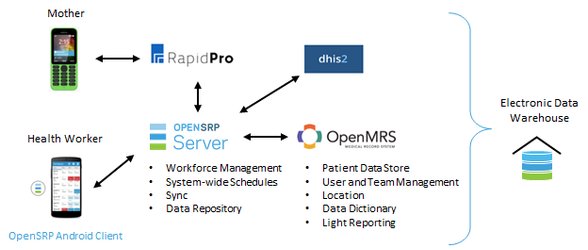OpenSRP Implementer's Guide
This implementer's guide focuses on the operational use and understanding of the OpenSRP platform. Technical details for setting up each of the OpenSRP systems and components are available in the Developer's Guide.
OpenSRP is a mobile platform that allows frontline health workers to electronically register and track their client populations, with implementations in Bangladesh, Kenya, Indonesia, Pakistan and Zambia. OpenSRP collects data on an Android mobile device, pushes that data to a deployment management system (OpenSRP Server) and integrates with an Electronic Medical Record System (OpenMRS) to provide scalable data management across large geographic areas. It is also possible to integrate OpenSRP with third party systems like DHIS2 system for automated reporting, RapidPro for direct to patient messaging and Electronic Data Warehouses for robust data analytics. Each component of the platform provides a function that supports the health workers in the clinic or community, centralized management of the deployment and a robust data repository that follows industry best practices. Below is a diagram of the full platform with data linkages defined.
OpenSRP synchronizes data across all systems, ensuring everything is always up to date. To put it another way, any data point added in the OpenSRP App, RapidPro, the OpenSRP Server or the OpenMRS Server will get synchronized across the system every time the user connects to the internet.
OpenSRP App (Android Mobile Device)
The OpenSRP App can be deployed on an Android mobile device running Android Marshmallow (5.0) or greater. The OpenSRP app functions offline and synchronizes data with the centralized server when an internet connection is available. The app is the core interface for collecting data in the platform. It is a secure mobile application that allows health workers to collect data on their patient population. The OpenSRP app is able to use a barcode scanner app to read QR codes to quickly pull up patient records. The user interface focuses on augmenting the current register-based workflow with digital data collection. The device can be connected to the internet through WIFI or a SIM card, so the data can be transmitted from the clinic to the OpenSRP Server.
OpenSRP Server
The OpenSRP server is the system that manages the mobile deployment. It contains technology that synchronizes data across all tablets, tracks changes in forms, provides updates on a regular schedule and integrates with OpenMRS. Additionally, OpenSRP Server is able to directly connect with third party systems as defined above.
OpenMRS Server
OpenMRS is the centralized data repository that provides role-based access controls, audits and reporting to other systems. It utilizes the transactional data model that has been proven at scale in numerous applications across the globe. This system manages the user access controls in both the centralized server and mobile deployment. It also allows for the separation of data by clinic site and team. The OpenMRS server allows end users to perform patient de-duplication, aggregation and reporting. The OpenMRS server is able to aggregate data locally and push data to DHIS2 using an Extract Transform Load (ETL) process.
RapidPro and the Aleena Health Assistant Bot (SMS/Facebook Messenger/Telegram)
OpenSRP has the ability to intelligently connect with patients and frontline health workers who do not have a device running the OpenSRP Android App. This connection utilizes RapidPro, which is an open source platform that allows implementers to create direct to patient messaging interactions through SMS, Facebook Messenger, and Telegram media. The current integration includes the ability to create and update contacts in RapidPro from clients in OpenSRP and kick off messaging campaigns.
DHIS2
OpenSRP can connect to DHIS2 in two ways, directly through OpenSRP server or through OpenMRS. OpenSRP server can integrate with DHIS2’s data sets as well as individual data in DHIS2 Tracker. OpenSRP also utilizes the tools developed by the OpenMRS community. In this way, OpenMRS can connect to DHIS2 for aggregate reporting and synchronization of facility metadata across the OpenSRP platform.
Data Analytics (Electronic Data Warehouse/Tableau)
Numerous reporting systems are supported for OpenSRP, including a scalable Electronic Data Warehouse (EDW), custom reporting interface and Tableau. These systems are utilized to support cross system reporting, deep learning and real-time dashboards. Tableau and other reporting front ends like SuperSet allow end users to directly query the data in the EDW and create robust visualizations. More generally, it's possible for any third-party reporting or statistical system to connect to both the OpenSRP and OpenMRS servers using an Extract, Transform, Load (ETL) process including Pentaho and Jasper Reports.

This site is no longer maintained. Please visit docs.opensrp.io for current documentation.